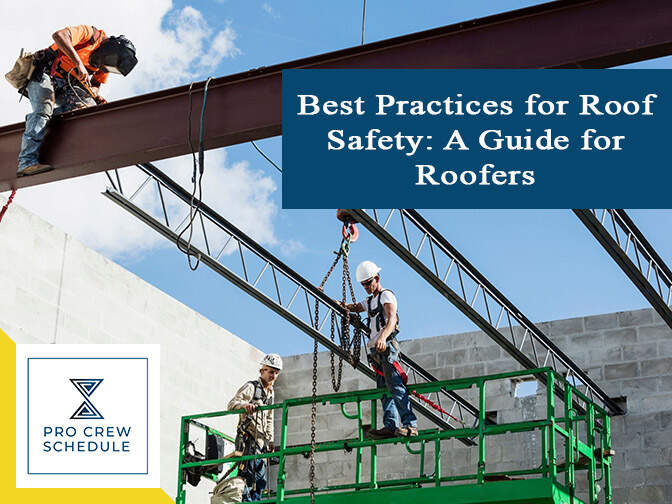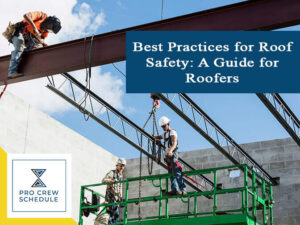Roofers have to pay the utmost attention while working at heights, ensuring that they won’t get injured or put anyone around at risk as they carry out their tasks. Roofs are unsafe, simply because of how elevated it is. Therefore, it is crucial to come up, execute and maintain effective safety measures while being at heights working on roofs. Roofing professionals have learned to exercise safety cautions when attempting to do roof inspections and repairs, particularly on commercial roofs.
For this blog, let’s begin understanding the importance of roof safety, including some of the best strategies to use.
9 Common Roofing Hazards
Roofs aren’t specifically designed for consistent roof traffic, yet repairs and inspections require roofers to tread lightly across roof metal panels and membranes. Several roof accidents involved falls and trips from the heights, which resulted in numerous deaths annually.
Below are some of the most common roofing threats faced by roofers:
1. Slippery Conditions
Stepping in on roofs can be hazardous, especially during snow and heavy rain. However, accidents mostly happen if there are unusual steep roof or perhaps a flat roof with gravel. That is why correct footwear and proper footwear are extremely important in accessing the roof.
2. Extreme heat
Roofers are not only working under the sun for several hours, but they are consistently surrounded by reflected heat. Thus, working in extreme hot conditions has made roofers at risk of heatstroke or dehydration. Being mindful of these things and one’s own health should be prioritized.
3. Vents & Ductwork
Exposed ductwork, vents and other obstructions bulging from the roof can block the roofer’s view. These obstructions have to be fixed right there and then. It is essential to identify these issues earlier. Tasks for roof inspections are scheduled accordingly using builder trends software.
4. Loose debris, wires and trees
Electrical wires extending across roofs are not a common thing anymore. The same way for the branches of trees that are usually obscuring the view. These two hazards can absolutely cause roofing professionals to fall or trip which sustain them some serious injuries.
5. Ladders
When ladders are improperly used, it can lead roofers to a severe fall and sudden demise. There have been buildings that never provide roof access from the inside. On the other hand, roofers don’t have any option but to use ladders to get straight up to the roofs.
6. Skylights
While these things are great for natural light, this type of fixture can give way anytime. Fixtures give way when there is so much weight placed on them. Workers have to make sure they aren’t stepping in it; otherwise, they will strip directly on the edges.
7. Parapet Walls
There are tall buildings that have no barrier situated on the roof ledges. If that is the case, it poses an immediate threat to the roofers. Some buildings have too short walls in order to prevent a worker from tumbling over.
8. Electrical
Workers have to be more aware of their designated roofing tasks. Being near powerlines is usually something that is being overlooked by the roofers. Dangerous sections like solar panels, conduit and HVAC equipment must be avoided.
9. Chemical exposure
There is a very high possibility that roofing professionals will touch toxins and breathe it in. Lead and asbestos are the toxins roofers have been exposed to especially when handling roofing materials. Other biological materials like bird and rodent droppings are also present and this will extremely harm the workers.
7 Ways to Ensure Safety for Roofers
Roofing companies are required to guarantee safety for their workers during task executions. Not only the employers must take all the steps essential to ensure this, but they also have to identify other considerations to control threats and hazards. Roofers have to be supervised and well-trained to carry out all their tasks safely. They are well-supervised using a crew scheduler software where monitoring and tracking every designated crew has been made convenient and faster.
Below are 5 ways to ensure roofer’s safety:
1. Wearing appropriate footwear with safety glasses, traction, gloves and hardhats when necessary. Always wear a harness and ensure it is tied off properly.
2. When using ladders, make sure to secure them using stabilizers or by other available means. This not only makes the ladders keep steady but it also prevent harm to the building’s gutter system.
3. Ensure work area is clean and organized. Tools and equipment must be blocked off from people to prevent unnecessary damage or injury. Using construction scheduling software, roofers will have an easy way of managing different resources. Thus, it promotes uniformity and results in an organization. Also, work areas for roofers must be separated from common hazard areas.
4. No work should be imposed during extreme heatwaves and unpredictable weather. Snow and rain can cause severe threats to roofers. Plan the job considering the weather and also ensure to have contingency plans to prevent losing too much time.
5. Workers have to clean up while working on roofs in order to lessen debris that might lead to injuries and falls.
6. Understand fall distance. Exact fall distances must be ascertained in any roofing job. The length of the lanyard and body length under the D-ring, including the harness system and anchor, are some of the most important factors to remember. More detailed instructions can be posted using builder software. All teams can access the files anywhere at any given time.
7. Use ladders appropriately. Several times, roofers often take things for granted like safety. Before a roofer can get up to a ladder, checking first the tool’s condition is a must.
Roof Fall Protection
Federal guidelines have been requiring roofing companies to provide protection for workers from roof falls. That is why using specific fall protection systems and equipment has been implemented even from the start. Additionally, these guidelines also mandate employers to give extensive training on the system and certain rescue and first aid techniques. Doing so will provide the entire team the knowledge to protect not just themselves but also their coworkers.
The fall protection system includes several basic components:
1. Guardrail systems
Guardrails are usually installed around the roof’s perimeter at steep and lower slope sites. It can be either temporary or permanent yet there are necessary requirements for composition, height and location involved in the process. Hence, roofing professionals have to be familiar with this list of items before selecting the right guardrail system. Furthermore, being knowledgeable in using any of the latest construction trends like the task scheduler software is also perceived as a crucial thing.
2. Safety nets
A safety net refers to a mesh or webbed system made from either synthetic or natural fibers. Nets for safety are suspended below a skylight or roof site to stop a falling worker. In fact, there are federal regulations involved around what safety nets must be made of or how often it needs to be tested.
3. Personal Fall Arrest
PFAs refers to body harnesses that every roofer has to wear. It is usually attached to the anchor by a lanyard. Most of the components are capable of holding any heavyweight and will also fit in specific ways. Roofers have to make sure that the PFA they used is certified and it also works in good condition.
4. Warning line systems
It is a chain barrier, wire or rope that will prevent roofers from entering unsafe areas. Take note that these are heavy-duty warning systems capable of enduring 500 lbs. of pressure. This system can be deployed on low-slope roofs and is preferably combined with guardrails or safety monitoring systems. Apparently, it is not a part of the mandatory protection for steep roof work.
5. Safety monitoring systems
A system for safety monitoring is also being used for roof fall protection with a lower slope. It wasn’t just a piece of equipment, but rather, it is more like a technique roofers used on roof sites. A person will be trained to familiarize further with fall hazards (monitor). This particular option is utilized with a warning line system.
6. Traction-Based
There’s still no strategy on how to walk barefoot on water. However, there’s the best way to walk on the roofs safely. Good thing that traction-based shoes are made because having the right shoes will prevent the likelihood of falls and slips.
Working in a Fast-Paced and Changing Roofing Industry
Roofing designs continuously evolve and change as consumers and architects keep up with new trends, styles and changing preferences. For instance, these green building standards are pointing out to more installed green roofs and solar panels. In addition, the rooftop garden has continued to progress in popularity. Thus, features no one has ever seen from the past. So what does it mean for the roofers?
The more features added to the roofs, the more traffic that can be expected on them – whether for maintenance staff, occupants, or builders to enjoy leisure spaces. But the truth is, the more people will occupy, the greater the risks for falls will be. It only means one thing – closer attention should be imposed for roof fall protection measures for the entire construction phases and application.
Key Takeaways
Roofing safety is reliant on the awareness of workers while working on the roof, their self-balance and their ability to multi-task. However, relying on acrobat skills is not advisable because it treacherously plays the probabilities of slipping. That is why roofing companies should prioritize their employee’s knowledge and understanding of the importance of safety.







